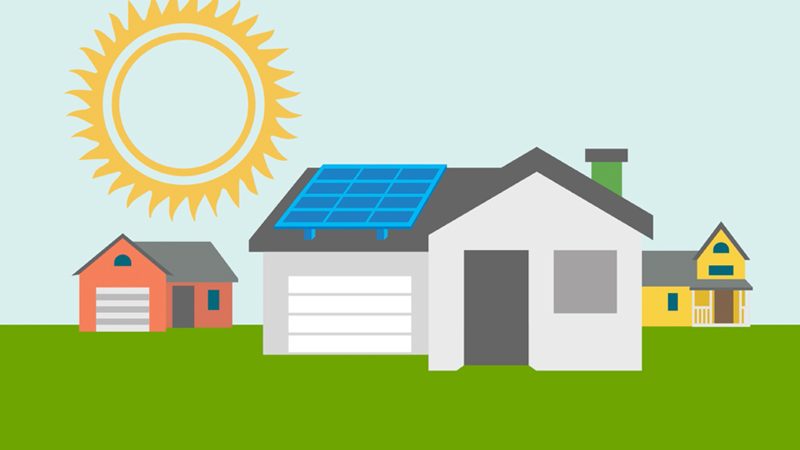Access to reliable source of power is a necessity for every household. Most households rely entirely on the national grid, some have back-up battery systems or generators, while those who have no access to the grid rely on generators and solar systems.
One challenge being faced by home owners in their attempt to embrace solar power, is little knowledge about the concept. This write-up therefore is an attempt to explain the components and working principle in simplified language. The explanation uses a residential rain water harvesting system as an analogy to a solar home system.
RAIN WATER HARVESTING SYSTEM | SOLAR HOME SYSTEM |
The Rain, The Roof, and the Gutter | The Sun & The Solar Panels |
The rain is the source of water. The amount of water collected depends on the size (area) of the roof. If more water is needed, then more roof space needs to be utilized, normally (for this analogy) by installing gutters on additional roofs. The amount of water required depends on the intended use, which is the sum of all rain water applications in the homestead. | The sun is the source of energy. The amount of solar energy generated depends on the capacity (watts) of the solar panels. If more energy is needed, then the wattage of the solar needs to be increased, normally by increasing the quantity of solar panels. The amount of energy required depends on the intended use, which is the sum of all energy consumed by the various household appliances. |
The Water Filter and the Float Valve | The Charge Controller |
The rain water is usually collected with all manner of impurities washed down from the roof such as leaves and stones, which, if A water filter is therefore included to trap A float valve is also installed in the storage tank to shut the water inlet when the tank is full. Excess water is then diverted to the overflow drain | The power generated from solar fluctuates based on the intensity of the sun. This results in sudden rise and drops in voltage and current. A solar battery needs to be charged at voltages and currents recommended by the manufacturer. Deviating from these may cause Excess power from the solar panels is thus prevented from overcharging the battery. Some inverters, commonly referred to as hybrid inverters, have inbuilt charge controllers. |
The Storage Tank | The Batteries |
Rain hardly falls at the time when the water is required for consumption, and if it does, the rate of consumption will hardly be equal to the rate of collection. This necessitates the installation of a storage tank to store the water for later use. A properly sized tank should be big enough to store as much water as possible, ideally to last until the next time the rain falls again. | The sun only shines during the day, but household appliances work at daytime as well as at night. Even during the day, the rate of power generation hardly matches the rate of consumption. Therefore, a battery bank is required to store energy for later use. A properly sized battery bank should be able to store enough energy (kilowatt-hours) to last until when the sun comes up the following to charge the batteries again. Solar batteries are special type designed for deep cycles and are more expensive compared to the normal car batteries. |
The Utility Water Supply | The Utility Power Supply |
The storage tank will normally have a second source of water supply,which for this analogy is assumed to be the local water company. It is only when the water level in the tank falls below a certain pre-set level (half-way in this example) that water from the utility will be allowed in. Therefore, utility water is the back-up to supplement rain water. | Most households will usually have utility power or generator connected. When a solar system is installed, the utility power will be rerouted to the inverter. The inverter will then be programmed to only connect to the utility under pre-set conditions, usually the state of charge of the batteries or the load condition on the inverter. Therefore, the utility power becomes the back-up to supplement the |
The Water Pump, Pressure Tank, and Pressure Switch | The Inverter |
The water pump is the interface between water collection and consumption. It takes water from the storage tank and pumps it to the various points of consumption. A properly sized pump should be capable of meeting the water requirements (litres per minute) of all the applications (toilet, laundry etc) even if they are all turned ON simultaneously. The pressure tank and pressure switch are fitted to ensure optimal and automatic operation of the pump. | The inverter is the interface between power generation, storage, and consumption. It converts DC power from the batteries into AC power required by the household appliances. A properly sized inverter should be able to supply enough power (watts) to all the connected appliances, even in the unlikely event that they are all turned ON at once. A good inverter should have the option of connecting utility power and programming it on when to actually consume the power. It should also be possible to set battery operation parameters to avoid over discharging the batteries, which reduces their life. |
Note:
The links provided in this write-up are picked from the internet and their content is entirely the property of the respective website owners. The purpose is only to provide clarification about the information and terms provided here. It should not in any way be assumed that we are promoting their products.







